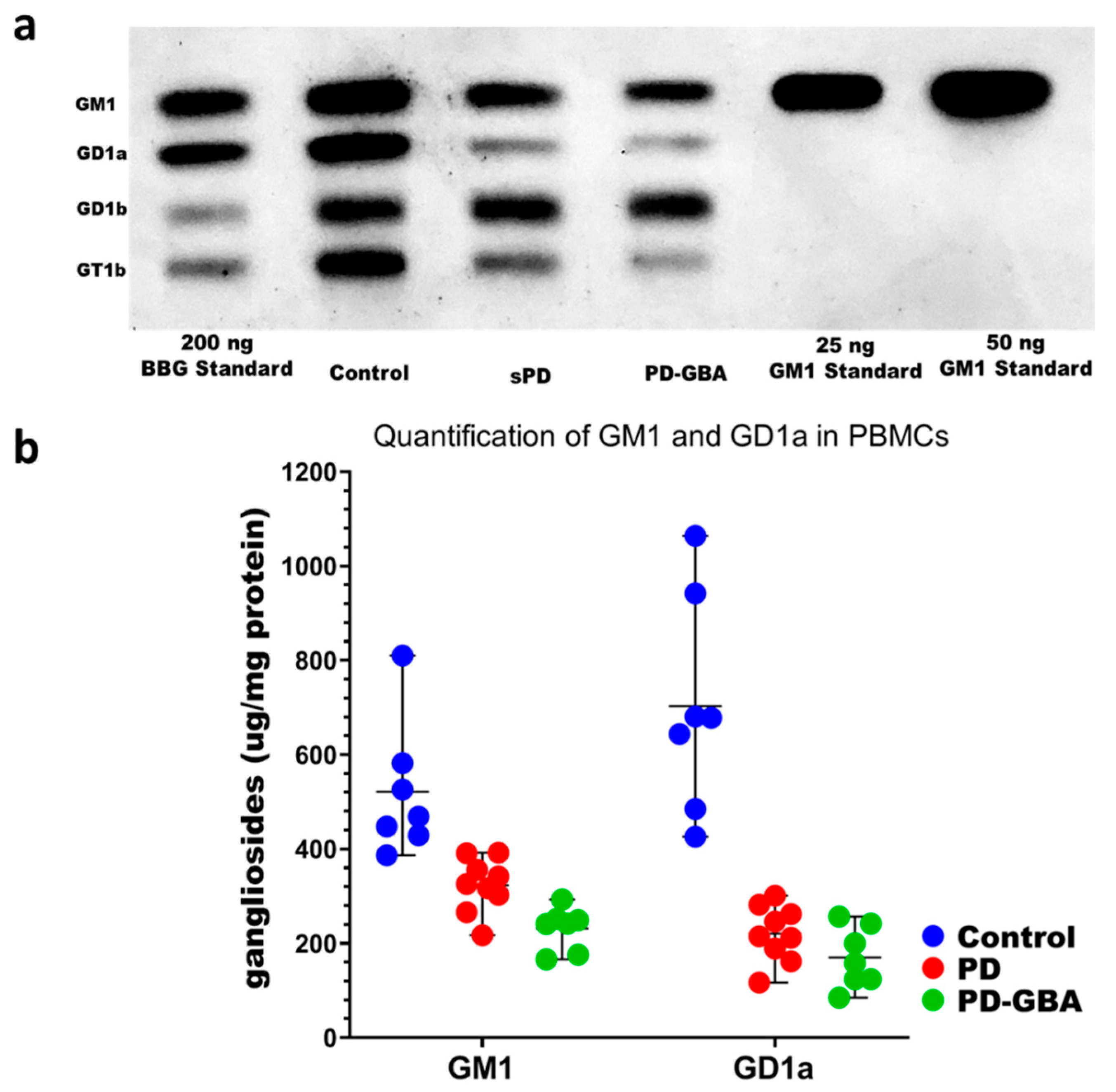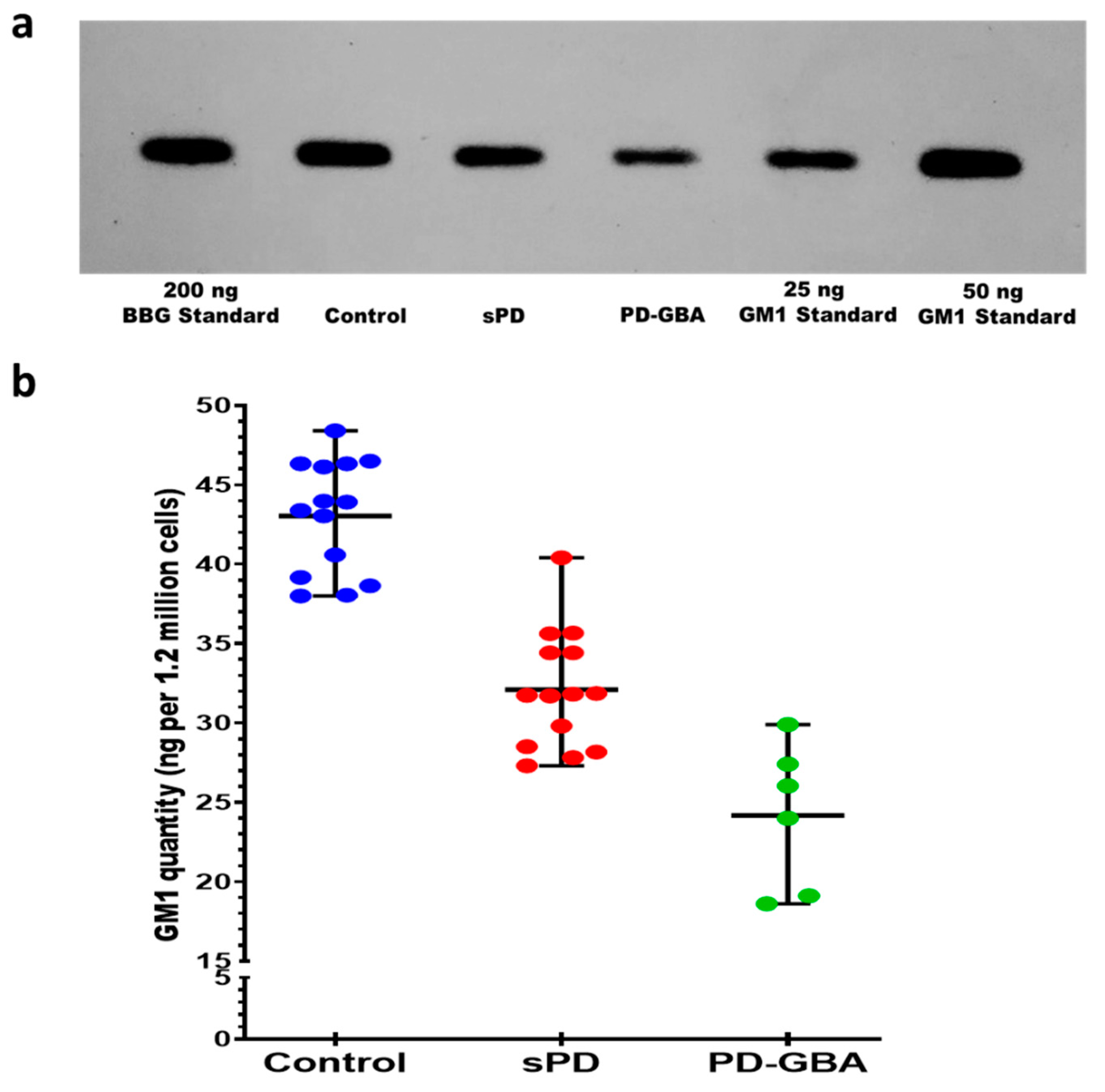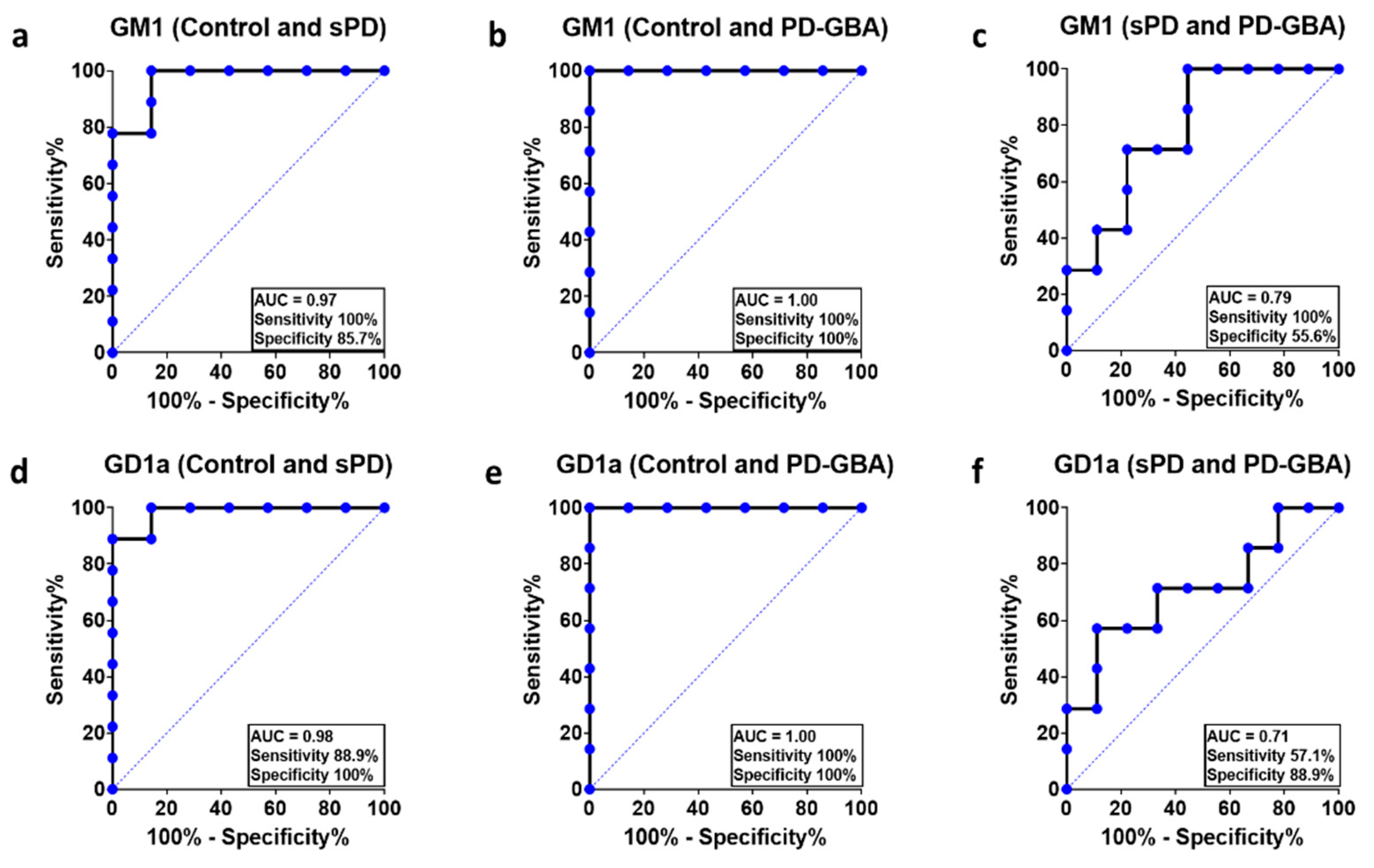Subnormal GM1 in PBMCs: Promise for Early Diagnosis of Parkinson’s Disease?
Abstract
1. Introduction
2. Results
2.1. Clinical Characteristics of sPD and PD-GBA Patients and Healthy Control Subjects
2.2. Original Method: Analysis of GM1 and GD1a in PBMCs
2.3. Modified Method: Analysis of GM1 in PBMCs
2.4. ROC Analysis of GM1 and GD1a in the PMBCs in sPD and PD-GBA Patients and Healthy Controls
2.4.1. Original Analytical Method
2.4.2. Modified Analytical Method
3. Discussion
4. Materials and Methods
4.1. Sample Collection and Patient Assessment
4.2. PBMCs Isolation
4.3. GM1 and GD1a Analysis
4.4. Modified Analytical Method for Analysis of GM1 Alone
4.5. Statistical Analysis
5. Conclusions
Author Contributions
Funding
Institutional Review Board Statement
Informed Consent Statement
Data Availability Statement
Conflicts of Interest
Abbreviations
| aSyn | Alpha-synuclein |
| AUC | Area under the ROC Curve |
| B3galt4 | Beta-1,3-Galatosyl transferase 4; GM1 Synthase |
| B4galnt1 | Beta-1,4-N-Acetyl-Galactosaminyltransferase 1; GM2 Synthase |
| BDNF | Brain-derived neurotrophic factor |
| CNS | Central nervous system |
| CSF | Cerebrospinal Fluid |
| CtxB | Cholera toxin B |
| DA | Dopamine; Dopaminergic neurons |
| GBA | Glucocerebrosidase |
| GDNF | Glial cell line derived neurotrophic factor |
| HPTLC | High performance thin-layer chromatography |
| HRP | Horseradish peroxidase |
| HSD | Honestly significant difference |
| N’ase | Neuraminidase |
| NEU3 | Neuraminidase 3 |
| NGF | Nerve growth factor |
| PBMC | Peripheral blood mononuclear cells |
| PBS | Phosphate-buffered saline |
| PD | Parkinson’s disease |
| PNS | Peripheral nervous system |
| REM | Rapid eye movement |
| ROC | Receiver operating characteristic |
| RPM | Revolutions per minute |
| sPD | Sporadic Parkinson’s disease |
| ST3gal2 | Beta-galactoside alpha-2,3-sialyltransferase 2; GD1a Synthase |
| TrkA | Tropomyosin receptor kinase A |
| TrkB | Tropomyosin receptor kinase B |
| UPDRS | Unified Parkinson’s disease rating scale |
References
- Dorsey, E.R.; Sherer, T.; Okun, M.S.; Bloem, B.R. The Emerging Evidence of the Parkinson Pandemic. J. Parkinsons Dis. 2018, 8, S3–S8. [Google Scholar] [CrossRef] [PubMed]
- Bohnen, N.I.; Albin, R.L. The cholinergic system and Parkinson disease. Behav. Brain Res. 2011, 221, 564–573. [Google Scholar] [CrossRef]
- Paredes-Rodriguez, E.; Vegas-Suarez, S.; Morera-Herreras, T.; De Deurwaerdere, P.; Miguelez, C. The noradrenergic system in Parkinson’s disease. Front. Pharmacol. 2020, 11, 435. [Google Scholar] [CrossRef] [PubMed]
- Politis, M.; Niccolini, F. Serotonin in Parkinson’s disease. Behav. Brain Res. 2015, 277, 136–145. [Google Scholar] [CrossRef] [PubMed]
- Ugrumov, M. Development of early diagnosis of Parkinson’s disease: Illusion or reality? CNS Neurosci. Ther. 2020, 26, 997–1009. [Google Scholar] [CrossRef] [PubMed]
- Ledeen, R.W.; Wu, G. The multi-tasked life of GM1 ganglioside, a true factotum of nature. Trends Biochem. Sci. 2015, 40, 407–418. [Google Scholar] [CrossRef] [PubMed]
- Chiricozzi, E.; Lunghi, G.; Di Biase, E.; Fazzari, M.; Sonnino, S.; Mauri, L. GM1 ganglioside is a key factor in maintaining the mammalian neuronal functions avoiding neurodegeneration. Int. J. Mol. Sci. 2020, 21, 868. [Google Scholar] [CrossRef] [PubMed]
- Ledeen, R.W.; Chowdhury, S.; Lu, Z.H.; Chakraborty, M.; Wu, G. Systemic deficiency of GM1 ganglioside in Parkinson’s disease tissues and its relation to the disease etiology. Glycoconj. J. 2021, in press. [Google Scholar]
- Mullin, S.; Hughes, D.; Mehta, A.; Schapira, A.H.V. Neurological effects of glucocerebrosidase gene mutations. Eur. J. Neurol. 2019, 26, 388–393. [Google Scholar] [CrossRef]
- Alcalay, R.N.; Levy, O.A.; Waters, C.C.; Fahn, S.; Ford, B. Glucocerebrosidase activity in Parkinson’s disease with and without GBA mutation. Brain 2015, 135, 2648–2658. [Google Scholar]
- Yohe, H.C.; Wallace, P.K.; Berenson, C.S.; Ye, S.; Reinhold, B.B.; Reinhold, V.N. The major gangliosides of human peripheral blood monocytes/macrophages: Absence of ganglio series structures. Glycobiology 2001, 11, 831–841. [Google Scholar] [CrossRef] [PubMed][Green Version]
- Wu, G.; Lu, Z.-H.; Gabius, H.-J.; Ledeen, R.W.; Bleich, D. Ganglioside GM1 deficiency in effector T cells from NOD mice induces resistance to regulatory T-cell suppression. Diabetes 2011, 60, 2341–2349. [Google Scholar] [CrossRef]
- Ledeen, R.W.; Wu, G. Gangliosides of the Nervous System. In Methods in Molecular Biology; Sonnino, S., Prinetti, A., Eds.; Elsevier: New York, NY, USA, 2018; Volume 1804, pp. 19–25. [Google Scholar]
- Ledeen, R.W.; Wu, G. Gangliosides, α-Synuclein, and Parkinson’s disease. In Progress in Molecular Biology and Translational Science: Gangliosides in Health and Disease; Schnaar, R.L., Lopez, P.H.H., Eds.; Academic Press: London, UK, 2018; Volume 156, pp. 435–454. [Google Scholar]
- Hadaczek, P.; Wu, G.; Sharma, N.; Ciesielska, A.; Bankiewicz, K.; Davidow, A.L.; Lu, Z.-H.; Forsayeth, J.; Ledeen, R.W. GDNF signaling implemented by GM1 ganglioside; failure in Parkinson’s disease and GM1-deficient murine model. Exp. Neurol. 2015, 263, 177–189. [Google Scholar] [CrossRef] [PubMed]
- Pascual, A.; Hidalgo-Figueroa, M.; Piruat, J.L.; Pintado, C.O.; Gomez-Diaz, R.; Lopez-Barneo, J. Absolute requirement of GDNF for adult catecholaminergic neuron survival. Nat. Neurosci. 2008, 11, 755–761. [Google Scholar] [CrossRef] [PubMed]
- Mutoh, T.; Tokuda, A.; Miyadai, T.; Hamaguchi, M.; Fujiki, N. Ganglioside GM1 binds to the Trk protein and regulates receptor function. Proc. Natl. Acad. Sci. USA 1995, 92, 5087–5091. [Google Scholar] [CrossRef] [PubMed]
- Pitto, J.; Mutoh, T.; Kuriyama, M.; Ferraretto, A.; Palestini, P.; Masserini, M. Influence of endogenous GM1 ganglioside on TrkB activity in cultured neurons. FEBS Lett. 1998, 439, 93–96. [Google Scholar] [CrossRef]
- Martinez, Z.; Zhu, M.; Han, S.; Fink, A.L. GM1 specifically interacts with α-synuclein and inhibits fibrillation. Biochemistry 2007, 46, 1868–1877. [Google Scholar] [PubMed]
- Bartels, T.; Kim, N.C.; Luth, E.S.; Selkoe, D.J. N-Alpha-acetylation of α-synuclein increases its helical folding propensity, GM1 binding specificity and resistance to aggregation. PLoS ONE 2014, 9, 103727. [Google Scholar] [CrossRef] [PubMed]
- Wu, G.; Lu, Z.-H.; Kulkarni, N.; Ledeen, R.W. Deficiency of ganglioside GM1 correlates with Parkinson’s disease in mice and humans. J. Neurosci. Res. 2012, 90, 1997–2008. [Google Scholar] [PubMed]
- Schneider, J.S.; Aras, R.; Williams, C.K.; Koprich, J.B.; Brotchie, J.M.; Singh, V. GM1 ganglioside modifies α-synuclein toxicity and is neuroprotective in a rat α-synuclein model of Parkinson’s disease. Sci. Rep. 2019, 9, 8362. [Google Scholar]
- Pellicano, C.; Benincasa, D.; Pisani, V.; Buttarelli, F.R.; Giovannelli, M.; Pontieri, F.E. Prodromal non-motor symptoms of Parkinson’s disease. Neuropsych. Dis. Treat. 2007, 3, 145–151. [Google Scholar] [CrossRef] [PubMed]
- Haliday, G.M.; Barker, R.A.; Rowe, D.B. Non-Dopamine Lesions in Parkinson’s Disease; Oxford University Press: Oxford, UK, 2011. [Google Scholar]
- Bhuiyan, R.H.; Ohmi, Y.; Ohkawa, Y.; Zhang, P.; Takano, M.; Hashimoto, N.; Okajima, T.; Furukawa, K.; Furukawa, K. Loss of enzyme activity in mutated B4GALNT1 gene products in patients with Hereditary Spastic Paraplegia results in relatively mild neurological disorders: Similarity with phenotypes of B4galnt1 knockout mice. Neuroscience 2019, 397, 94–106. [Google Scholar] [CrossRef]
- Nalls, M.A.; Blauwendraat, C.; Vallerga, C.L.; Heilbron, K.; Bandres-Ciga, S.; Chang, D.; Tan, M.; Kia, D.A.; Noyce, A.J.; Xue, A.; et al. Identification of novel risk loci, causal insights, and heritable risk for Parkinson’s disease: A meta-analysis of genome-wide association studies. Lancet Neurol. 2019, 18, 1091–1102. [Google Scholar] [CrossRef]
- Schneider, J. Altered expression of genes involved in ganglioside biosynthesis in substantia nigra neurons in Parkinson’s disease. PLoS ONE 2018, 13, e0199189. [Google Scholar] [CrossRef] [PubMed]
- Tsai, Y.T.; Yu, R.K. Epigenetic activation of mouse ganglioside synthase genes: Implications for neurogenesis. J. Neurochem. 2014, 128, 101–110. [Google Scholar] [CrossRef] [PubMed]
- Itokazu, Y.; Tsai, Y.T.; Yu, R.K. Epigenetic regulation of ganglioside expression in neural stem cells and neuronal cells. Glycoconj. J. 2016, 34, 749–756. [Google Scholar] [CrossRef] [PubMed]
- Svennerholm, L.; Bostrom, K.; Jungbjer, B.; Olsson, L. Membrane lipids of adult human brain: Lipid composition of frontal and temporal lobe in subjects of age 20 to 100 years. J. Neurochem. 1994, 63, 1802–1811. [Google Scholar] [CrossRef]
- Svennerholm, L.; Bostrom, K.; Fredman, P.; Mansson, J.E.; Rosengren, D.; Rynmark, B.M. Human brain gangliosides: Developmental changes from early fetal stage to advanced age. Biochim. Biophys. Acta 1989, 1005, 109–117. [Google Scholar] [CrossRef]
- Miyagi, T.; Yamaguchi, K. Mammalian sialidases: Physiological and pathological roles in cellular functions. Glycobiology 2012, 22, 880–896. [Google Scholar] [CrossRef] [PubMed]
- Schneider, J.S.; Sendek, S.; Daskalakis, C.; Cambi, F. GM1 ganglioside in Parkinson’s disease: Results of a five-year open study. J. Neuro. Sci. 2010, 292, 45–51. [Google Scholar] [CrossRef] [PubMed]
- Schneider, J.S.; Gollomp, S.M.; Sendek, S.; Colcher, A.; Cambi, F.; Du, W. A randomized, controlled, delayed start trial of GM1 ganglioside in treated Parkinson’s disease patients. J. Neurol. Sci. 2013, 324, 140–148. [Google Scholar] [CrossRef]
- Wu, G.; Lu, Z.-H.; Seo, J.H.; Alselehdar, S.K.; DeFrees, S.; Ledeen, R.W. Mice deficient in GM1 manifest both motor and non-motor symptoms of Parkinson’s disease; successful treatment with synthetic GM1 ganglioside. Exp. Neurol. 2020, 329, 113284. [Google Scholar] [CrossRef]
- Caronti, B.; Tanda, G.; Colosimo, C.; Ruggieri, S.; Calderaro, C.; Palladini, G.; Pontieri, F.E.; Di Chiara, G. Reduced dopamine in peripheral blood lymphocytes in Parkinson’s disease. Neuroreport 1999, 10, 2907–2910. [Google Scholar] [CrossRef] [PubMed]
- Caronti, B.; Antonini, G.; Caslderaro, C.; Ruggieri, S.; Palladini, G.; Pontieri, F.E.; Colosimo, C. Dopamine transporter immunoreactivity in peripheral blood lymphocytes in Parkinson’s disease. J. Neural Trans. 2001, 108, 803–807. [Google Scholar] [CrossRef] [PubMed]
- Huebecker, M.; Moloney, E.B.; van der Spoel, A.C.; Priestman, D.A.; Isacson, O.; Hallett, P.J.; Platt, F.M. Reduced sphingolipid hydrolase activities, substrate accumulation and ganglioside decline in Parkinson’s disease. Mol. Neurodegener. 2019, 14, 1–21. [Google Scholar] [CrossRef]
- Padmanabhan, S.; Lanz, T.A.; Gorman, D.; Wolfe, M.; Joyce, A.; Cabrera, C.; Lawrence-Henderson, R.; Levers, N.; Joshi, N.; Ma, T.C.; et al. An assessment of LRRK2 serine 935 phosphorylation in human peripheral blood mononuclear cells in idiopathic Parkinson’s disease and G2019S LRRK2 cohorts. J. Parkinson’s Dis. 2020, 10, 623–629. [Google Scholar] [CrossRef] [PubMed]
- Lees, M.B.; Paxman, S. Modification of the Lowry procedure for the analysis of proteolipid protein. Anal. Biochem. 1972, 47, 184–192. [Google Scholar] [CrossRef]
- Skowron, M.; Zakrzewski, R.; Ciesielski, W. Application of thin-layer chromatography image analysis technique in quantitative determination of sphingomyelin. J. Anal. Chem. 2016, 71, 808–813. [Google Scholar] [CrossRef]
- Youden, W.J. Index for Rating Diagnostic Tests. Cancer 1950, 3, 32–35. [Google Scholar] [CrossRef]
- Schisterman, E.F.; Perkins, N.J.; Liu, A.; Bondell, H. Optimal cut-point and its corresponding Youden index to discriminate individuals using pooled blood samples. Epidemiology 2005, 16, 73–81. [Google Scholar] [CrossRef] [PubMed]




| Cohort I | |||
|---|---|---|---|
| Parameter | Control | sPD | PD-GBA |
| N | 7 | 9 | 7 |
| Sex (male/female) | 2/5 | 6/3 | 2/5 |
| Age | 62.39 ± 3.58 | 66.28 ± 3.15 | 65.96 ± 2.94 |
| Age at disease onset | N/A | 57.00 ± 2.89 | 62.57 ± 2.81 |
| Disease duration | N/A | 9.28 ± 2.11 | 3.39 ± 0.78 |
| UPDRS I and II | 0.14 ± 0.14 | 8.56 ± 1.43 | 7.60 ± 3.5 |
| UPDRS III | 0.29 ± 0.18 | 16.89 ± 2.54 | 15.75 ± 3.94 |
| UPDRS Total | 0.43 ± 0.20 | 25.44 ± 3.11 | 20.25 ± 5.36 |
| Cohort II | |||
|---|---|---|---|
| Parameter | Control | sPD | PD-GBA |
| N | 14 | 14 | 6 |
| Sex (male/female) | 6/8 | 9/5 | 3/3 |
| Age | 68.86 ± 2.25 | 64.38 ± 2.84 | 65.12 ± 2.79 |
| Age at disease onset | N/A | 57.07 ± 3.08 | 57.00 ± 4.28 |
| Disease duration | N/A | 7.76 ± 1.66 | 8.12 ± 1.93 |
| UPDRS I and II Score | 0.50 ± 0.26 | 7.64 ± 1.44 | 8.00 ± 1.29 |
| UPDRS III Score | 1.83 ± 0.72 | 19.45 ± 2.41 | 18.60 ± 5.47 |
| UPDRS Total | 2.55 ± 0.77 | 27.09 ± 3.31 | 22.00 ± 4.80 |
Publisher’s Note: MDPI stays neutral with regard to jurisdictional claims in published maps and institutional affiliations. |
© 2021 by the authors. Licensee MDPI, Basel, Switzerland. This article is an open access article distributed under the terms and conditions of the Creative Commons Attribution (CC BY) license (https://creativecommons.org/licenses/by/4.0/).
Share and Cite
Alselehdar, S.K.; Chakraborty, M.; Chowdhury, S.; Alcalay, R.N.; Surface, M.; Ledeen, R. Subnormal GM1 in PBMCs: Promise for Early Diagnosis of Parkinson’s Disease? Int. J. Mol. Sci. 2021, 22, 11522. https://doi.org/10.3390/ijms222111522
Alselehdar SK, Chakraborty M, Chowdhury S, Alcalay RN, Surface M, Ledeen R. Subnormal GM1 in PBMCs: Promise for Early Diagnosis of Parkinson’s Disease? International Journal of Molecular Sciences. 2021; 22(21):11522. https://doi.org/10.3390/ijms222111522
Chicago/Turabian StyleAlselehdar, Samar K., Monami Chakraborty, Suman Chowdhury, Roy N. Alcalay, Matthew Surface, and Robert Ledeen. 2021. "Subnormal GM1 in PBMCs: Promise for Early Diagnosis of Parkinson’s Disease?" International Journal of Molecular Sciences 22, no. 21: 11522. https://doi.org/10.3390/ijms222111522
APA StyleAlselehdar, S. K., Chakraborty, M., Chowdhury, S., Alcalay, R. N., Surface, M., & Ledeen, R. (2021). Subnormal GM1 in PBMCs: Promise for Early Diagnosis of Parkinson’s Disease? International Journal of Molecular Sciences, 22(21), 11522. https://doi.org/10.3390/ijms222111522






